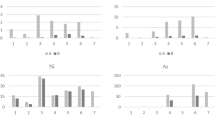Abstract
The structure and properties of the electroerosive powder fabricated from the electrotechnical aluminum waste are investigated, and the efficiency of application of electrodispersion is shown. It ensures the production of new powder materials suitable for additive technologies at low energy consumption. The fabricated powders are shown to have a spherical or elliptical shape; the main elements in them are Al and O; the main phases are Al2O3, Al2O3⋅3H2O, and Al(OH)3; and the aspect ratio of particles 25.489 μm in size is 1.245. 50% of the particles have a size of less than 25.489 μm. Note that 35% of the total sample volume is occupied by particles 20.0–50.0 μm in size.






Similar content being viewed by others
REFERENCES
A. Safdar, H. Z. He, L. Y. Wei, A. Snis, et al., “Effect of process parameters settings and thickness on surface roughness of EBM produced Ti–6Al–4V,” Rapid Prototyp. J. 18 (5), 401–408 (2012).
L. Loeber, S. Biamino, U. Ackelid, et al., “Comparison of selective laser and electron beam melted titanium aluminides,” in Proceedings of 22nd International Symposium on Solid Freeform Fabrication (Austin, 2011), pp. 547–556.
J. Karlsson, A. Snis, H. Engqvist, and J. Lausmaa, “Characterization and comparison of materials produced by electron beam melting (EBM) of two different Ti–6Al–4V powder fractions,” J. Mater. Process. Technol. 213 (12), 2109–2118 (2013).
A. Safdar, L. Y. Wei, A. Snis, and Z. Lai, “Evaluation of microstructural development in electron beam melted Ti–6Al–4V,” Mater. Character. 65, 8–15 (2012).
S. Biamino, A. Penna, U. Ackelid, et al., “Electron beam melting of Ti–48Al–2Cr–2Nb alloy: microstructure and mechanical properties investigation,” Intermetallics 19, 776–781 (2011).
D. D. Gu, W. Meiners, K. Wissenbach, and R. Poprawe, “Laser additive manufacturing of metallic components: materials, processes and mechanisms,” Int. Mater. Rev. 57 (3), 133–164 (2012).
B. Song, S. Dong, P. Coddet, et al., “Fabrication and microstructure characterization of selective laser melted FeAl intermetallic parts,” Surf. Coat. Technol. 206, 4704–4709 (2012).
Z. Wang, K. Guana, and M. Gaoa, “The microstructure and mechanical properties of deposited-IN718 by selective laser melting,” J. Alloys Compd. 513, 518–523 (2012).
R. K. Bairamov and Yu. Yu. Somova, “Mechanism of electric spark dispersion of aluminum in aqueous solutions,” Russ. J. Inorg. Chem. 59 (4), 368–372 (2014).
V. I. Kononenko, I. A. Chupova, I. N. Latosh, N. V. Lukin, and V. G. Shevchenko, “Oxidation of powdered alloys of aluminum and cerium during heating in air,” Combust., Explos., Shock Waves 37 (4), 413–417 (2001).
V. G. Shevchenko, “Effect of alloying on the kinetics and mechanism of oxidation of powdered aluminum-based alloys with rare- and alkaline-earth metals,” Combust., Explos., Shock Waves 47 (2), 166–173 (2011).
A. Yu. Kem, “Effect of the compacting conditions on the structure and properties of powdered aluminum alloys containing copper and magnesium,” Soviet Powder Metall. Met. Ceram. 31 (8), 675–679 (1993).
K. K. Palekha, “Aluminum base heat-resistant alloys with additions of iron from powdered materials obtained by the method of rapid solidification of the melt,” Soviet Powder Metall. Met. Ceram. 25 (7), 563–566 (1986).
K. K. Palekha, “Aluminum base heat-resistant alloys with additions of iron from powdered materials obtained by the method of rapid solidification of the melt,” Soviet Powder Metall. Met. Ceram. 25 (7), 563–566 (1986).
R. A. Latypov, G. R. Latypova, E. V. Ageeva, and O. V. Kruglyakov, “Electroerosion micro- and nanopowders for the production of hard alloys,” Russ. Metall. (Metally), No. 6, 547–549 (2016).
E. V Ageev., A. S. Ugrimov, and R. A. Latypov, “Metallurgical features of the manufacture of hard-alloy powders by electroerosive dispersion of a T15K6 alloy in butanol,” Russ. Metall. (Metally), No. 12, 1155–1157 (2016).
E. V. Ageev and R. A. Latypov, “Fabrication and investigation of carbide billets from powders prepared by electroerosive dispersion of tungsten-containing wastes,” Russ. J. Non-Ferrous Met. 55 (6), 577–580 (2014).
G. R. Latypova, N. N. Karpenko, R. A. Latypov, and E. V. Ageeva, “Composition and properties of the powder fabricated by electroerosive dispersion of the high-speed tool steel waste,” Elektrometallurgiya, No. 3, 25–29 (2020).
Author information
Authors and Affiliations
Corresponding author
Additional information
Translated by K. Shakhlevich
Rights and permissions
About this article
Cite this article
Latypov, R.A., Ageev, E.V., Latypova, G.R. et al. Structure and Properties of the Powders Produced by the Electrodispersion of the Aluminum Waste and Intended for Additive Technologies. Russ. Metall. 2021, 1598–1603 (2021). https://doi.org/10.1134/S0036029521120132
Received:
Revised:
Accepted:
Published:
Issue Date:
DOI: https://doi.org/10.1134/S0036029521120132




